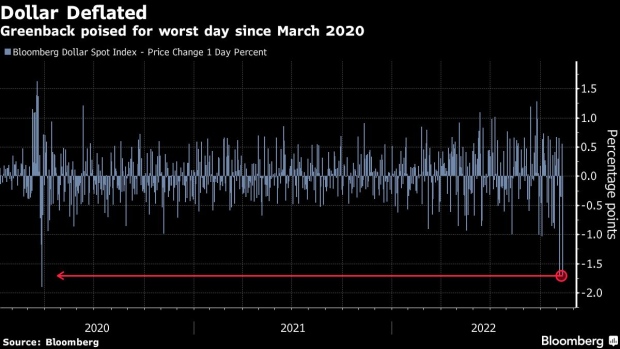Nov 10, 2022
Dollar Dives as CPI Surprise Cuts Fed Interest-Rate Hike Outlook
, Bloomberg News

(Bloomberg) -- The dollar had its worst day since 2009 after Thursday’s US inflation report surprised traders with slower growth in consumer prices, driving speculation that the Federal Reserve will ease the pace of its interest-rate increases.
The Bloomberg Dollar Spot Index fell 2% after a key inflation gauge cooled in October by more than expected, the biggest drop since 2009.
The consumer price report offered hope that the fastest price gains in decades are ebbing and giving Federal Reserve officials room to slow down amid an aggressive tightening campaign. Traders dialed back expectations to how high they expect rates to go before the Fed stops hiking, the so-called terminal rate of the cycle.
A slower pace of rate hikes could curb the dollar’s rally this year which has weakened its Group-of-10 currency peers. One-month risk reversals on the greenback, a gauge of option positioning and sentiment, fell to their lowest level since June, a sign that dollar demand may be waning.
“The softer core CPI reading is leading to markets to reprice the terminal rate lower,” said Bipan Rai, head of foreign-exchange strategy at Canadian Imperial Bank of Commerce. “That’s leading to further pain right now in the dollar.”
The market expectation is now showing that a 50-basis-point hike in December is far more likely than a 75-basis-point move, lowering the rates differential with the European Central Bank and the Bank of England.
The yen gained close to 4%, leading gains among Group-of-10 currencies. In this environment for the dollar, the yen and South African rand have room to outperform, said Gregory Marks, a foreign-exchange trader at HSBC.
“The market has found itself on the wrong side in a big way with averages on positions likely being challenged.” he said.
European currencies surged against the dollar, with the pound climbing as much as 3.3% to the highest since mid-September. The euro rose as much as 2.1% to the highest in nearly two months, while the Swiss franc jumped over 2% versus the greenback. The move lower in the greenback may not, however, be one-way traffic going forward.
“The Fed is likely to remind the market that underlying inflation is still three-times higher than target and remains persistent, so some of the selloff in the dollar and the rise in risk appetite could be misplaced,” Jane Foley, a strategist at Rabobank in London, said.
--With assistance from Robert Fullem.
(Updates prices. A previous version of this story was corrected to fix reference to size of dollar’s daily decline.)
©2022 Bloomberg L.P.






